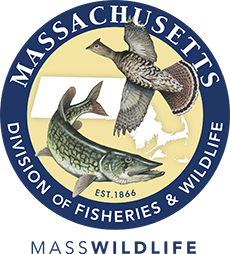- Division of Fisheries and Wildlife
Media Contact
Media Contact, MassWildlife

To many, the “Spring’s here!” two-note song of the black-capped chickadee is a hopeful sign that spring has nearly arrived. With that sound of spring, billions of migratory birds begin the trek to their breeding grounds, including species like the vibrant scarlet tanager that travel more than 4,000 miles! As the weather becomes milder, those with an attentive ear can hear changes in the bird community. Some of the first to arrive in Massachusetts include the American woodcock, eastern phoebe, and yellow-bellied sapsucker. As spring advances, the sounds of field sparrows, eastern towhees, Tennessee warblers, and Swainson’s thrushes fill the air. Some of these bird species are just passing through on their journey to northern New England or Canada, while others may be staking their claim on a piece of the Bay State where they will nest and raise their young.
Massachusetts is home to hundreds of bird species, most of which are migratory. These birds can be broken down into major groups based on a general description of their habitat (e.g., forest, grassland, and shrubland). Regardless of their habitat grouping, many of these species are experiencing population declines. Thirty different birds are listed under the Massachusetts Endangered Species Act. An additional 95 are listed as Species of Greatest Conservation Need (SGCN) on the Massachusetts State Wildlife Action Plan (SWAP).
Eastern forest birds are declining at an alarming rate, with a loss of nearly 170 million birds over the past 50 years. Massachusetts has close to 3 million acres of forests under both public and private ownership, so it may be puzzling to hear that many forest birds in the Commonwealth are in trouble. A close look at Massachusetts forests reveals that most of them are made up of similarly aged trees, and just a handful of tree species make up the bulk of our forests. This uniformity impacts bird species that need a variety of forest conditions to thrive.
The wood thrush is one familiar example of a bird that needs a variety of forest conditions. Wood thrush adults nest in mature forests, but feed and raise their fledglings in young forests. To help declining birds like the wood thrush, conservation efforts are needed to create and maintain a diversity of forest conditions that meet their entire breeding season habitat requirements.
Luckily, state and federal agencies are working to create habitat for declining birds and other types of wildlife on private and public lands. On public land, great examples can be found on numerous Wildlife Management Areas (WMA), as well as several State Forests and Parks. Restored forest communities found at Montague Plains WMA, Muddy Brook WMA, Birch Hill WMA, and Myles Standish State Forest are diverse and support many declining forest birds, including the iconic eastern whip-poor-will and prairie warbler.
Since 64% of Massachusetts forests are privately owned, actions taken by private landowners make a big difference to declining wildlife. Programs, like those offered by Natural Resource Conservation Service (NRCS) Working Lands for Wildlife (WLFW) and the Regional Conservation Partnership Program (RCPP), provide financial and technical assistance to landowners wishing to create wildlife habitat on their property.
